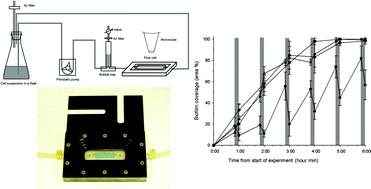The colonization of catheters by microorganisms is a serious problem that can lead to the development of resistant biofilm-related infections. Lethal photosensitisation is a possible solution as it is capable of inactivating microorganisms through the generation of reactive oxygen species. Previously we have shown that a Methylene Blue and gold nanoparticle-embedded silicone material has antimicrobial properties against planktonic bacteria when exposed to laser light. In this work the material has been tested for its ability to reduce the formation of Staphylococcus epidermidis biofilms. Biofilm formation was observed over time using a flow cell which was arranged to allow laser irradiation in situ. The duration and frequency of light exposure were changed so that the same amount of energy was delivered during each experiment. Neither short (5 min) but frequent (every 30 min) irradiation nor long (20 min) and infrequent (every 120 min) exposure was able to significantly prevent biofilm formation; they resulted in 75% and 60%, respectively, of the surface covered by the biofilm after 6 hour of colonization compared to 100% coverage when no laser was used. However, when laser irradiation was performed for 10 min every 60 min, a reduction in biofilm coverage of greater than 50% was observed compared to untreated silicone. The properties of the materials post-irradiation were also evaluated; the surface roughness of the material, the asperity density and the asperity height showed a continuous decrease with energy dose. However, the elasticity (Young's module) was not affected by the irradiation. This appears to be a promising novel light-activated material which, as well as displaying antimicrobial activity, has been shown for the first time capable of reducing biofilm formation over time.

You have access to this article
 Please wait while we load your content...
Something went wrong. Try again?
Please wait while we load your content...
Something went wrong. Try again?


 Please wait while we load your content...
Please wait while we load your content...